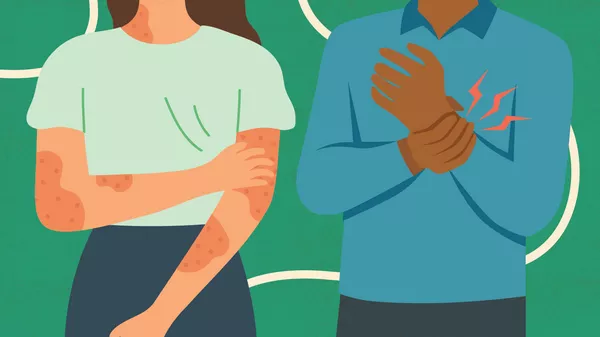Psoriatic arthritis (PsA) is a chronic inflammatory condition that affects individuals with psoriasis, a skin disorder characterized by red, scaly patches. While both conditions are autoimmune-mediated, PsA presents its own unique challenges due to its varied clinical manifestations. Understanding the different types of PsA is crucial for accurate diagnosis, effective management, and improved patient outcomes.
Symmetric Psoriatic Arthritis
One of the most common types of PsA, symmetric PsA affects joints on both sides of the body simultaneously, mirroring each other in terms of inflammation and pain. This symmetry distinguishes it from other forms of arthritis like rheumatoid arthritis. Symmetric PsA often resembles rheumatoid arthritis in its presentation, with swollen and tender joints, morning stiffness, and fatigue. It can affect any joint, including the small joints of the hands and feet, as well as larger joints such as the knees, hips, and shoulders.
Asymmetric Psoriatic Arthritis
In contrast to symmetric PsA, asymmetric PsA affects joints in a non-symmetrical pattern. This type of PsA can involve any joint, but it typically affects fewer joints compared to symmetric PsA. Asymmetric PsA is characterized by inflammation, pain, and swelling in joints that may not match on both sides of the body. It commonly affects joints in the fingers and toes, causing dactylitis or “sausage digits,” a hallmark feature of the disease. Asymmetric PsA can also involve the spine, leading to inflammatory back pain similar to ankylosing spondylitis.
Distal Interphalangeal Predominant Psoriatic Arthritis
Distal interphalangeal predominant PsA primarily affects the distal joints of the fingers and toes, including the joints closest to the nails. This type of PsA is characterized by inflammation and swelling in these joints, often leading to deformities such as nail pitting, onycholysis (separation of the nail from the nail bed), and arthritis mutilans (severe joint damage resulting in deformity). Distal interphalangeal predominant PsA may occur in conjunction with other forms of PsA or psoriasis, or it may present independently.
Spondylitis Psoriatic Arthritis
Spondylitis PsA primarily affects the spine and sacroiliac joints, leading to inflammation, stiffness, and pain in the lower back and buttocks. This type of PsA is often associated with inflammatory bowel disease (IBD), particularly Crohn’s disease and ulcerative colitis. Spondylitis PsA can cause progressive damage to the spine, resulting in fusion of the vertebrae and loss of mobility. Early diagnosis and treatment are essential to prevent irreversible structural damage and preserve spinal function.
Enthesitis Psoriatic Arthritis
Enthesitis PsA is characterized by inflammation at the entheses, the sites where tendons or ligaments attach to bone. Common sites of enthesitis include the Achilles tendon, plantar fascia, and the points where ligaments attach to the spine (e.g., the sacroiliac joints). Enthesitis can cause pain, swelling, and tenderness at these sites, often leading to difficulty with movement and physical activity. Enthesitis PsA may occur independently or in conjunction with other types of PsA.
Oligoarticular Psoriatic Arthritis
Oligoarticular PsA affects a small number of joints, typically fewer than five. This type of PsA can present as either symmetric or asymmetric and may involve any combination of joints, including the knees, ankles, wrists, and elbows. Oligoarticular PsA often presents early in the disease course and may progress to involve more joints over time. Early recognition and treatment are essential to prevent joint damage and preserve joint function.
Polyarticular Psoriatic Arthritis
Polyarticular PsA affects five or more joints and can resemble other forms of inflammatory arthritis such as rheumatoid arthritis. This type of PsA can be symmetric or asymmetric and typically involves both small and large joints. Polyarticular PsA may cause significant pain, swelling, and stiffness, leading to impaired mobility and reduced quality of life. Timely intervention with disease-modifying antirheumatic drugs (DMARDs) and biologic therapies is critical to control inflammation and prevent joint damage.
Mutilans Psoriatic Arthritis
Mutilans PsA is a severe and destructive form of the disease characterized by rapid joint destruction and deformity. This type of PsA can affect any joint but most commonly involves the small joints of the hands and feet. Mutilans PsA can lead to telescoping fingers and toes, also known as “opera glass hands” and “pencil-in-cup deformity,” respectively. Early diagnosis and aggressive treatment with DMARDs and biologic agents are essential to prevent irreversible joint damage and disability.
Conclusion
Psoriatic arthritis encompasses a spectrum of clinical phenotypes, each with its own unique features and challenges. Recognizing the different types of PsA is crucial for accurate diagnosis and tailored treatment approaches. A multidisciplinary approach involving rheumatologists, dermatologists, and other healthcare providers is essential to effectively manage PsA and improve patient outcomes. By understanding the varied presentations of PsA, clinicians can provide personalized care that addresses the individual needs and concerns of each patient.
Related Topics:
What Does Beginning Psoriasis Look Like

























